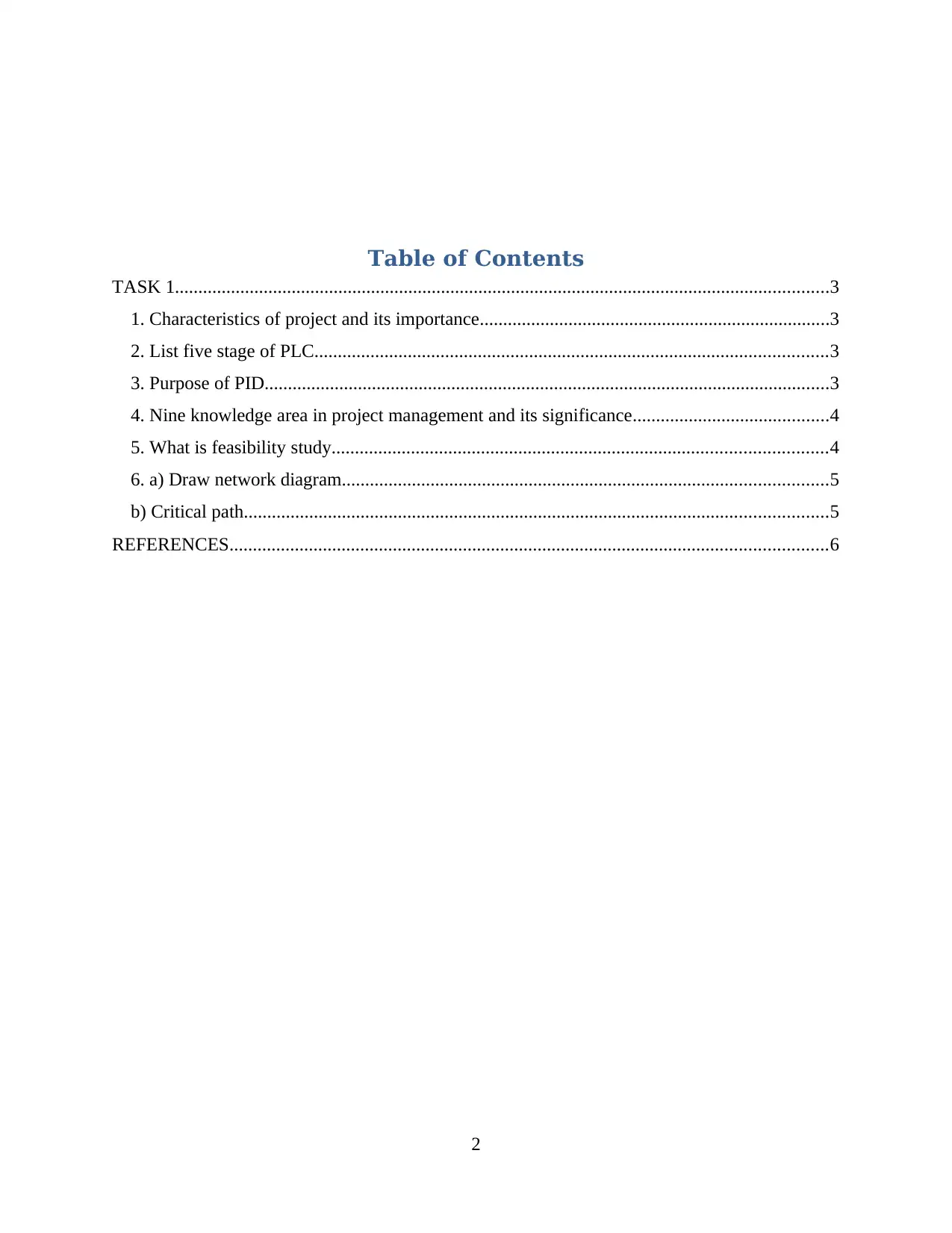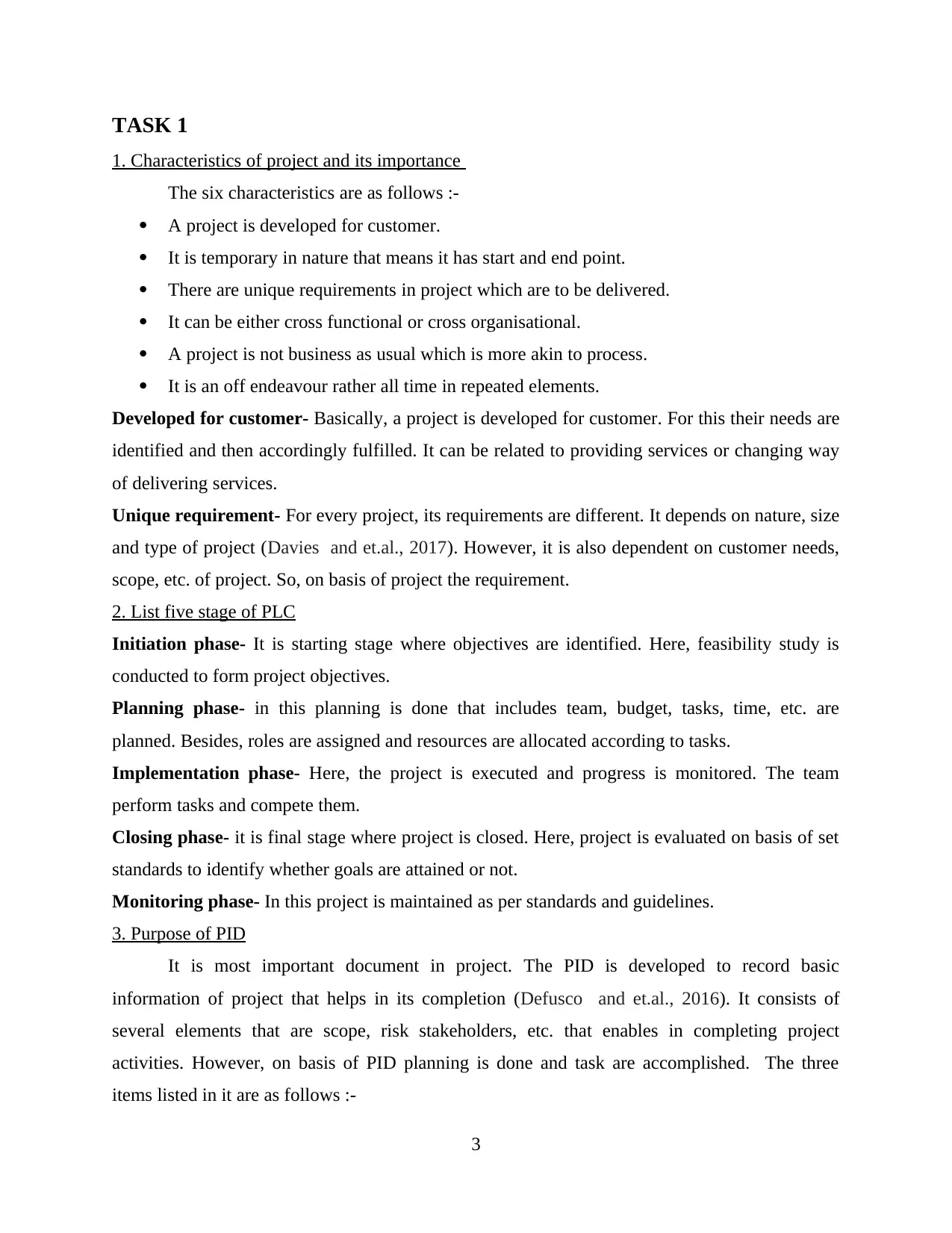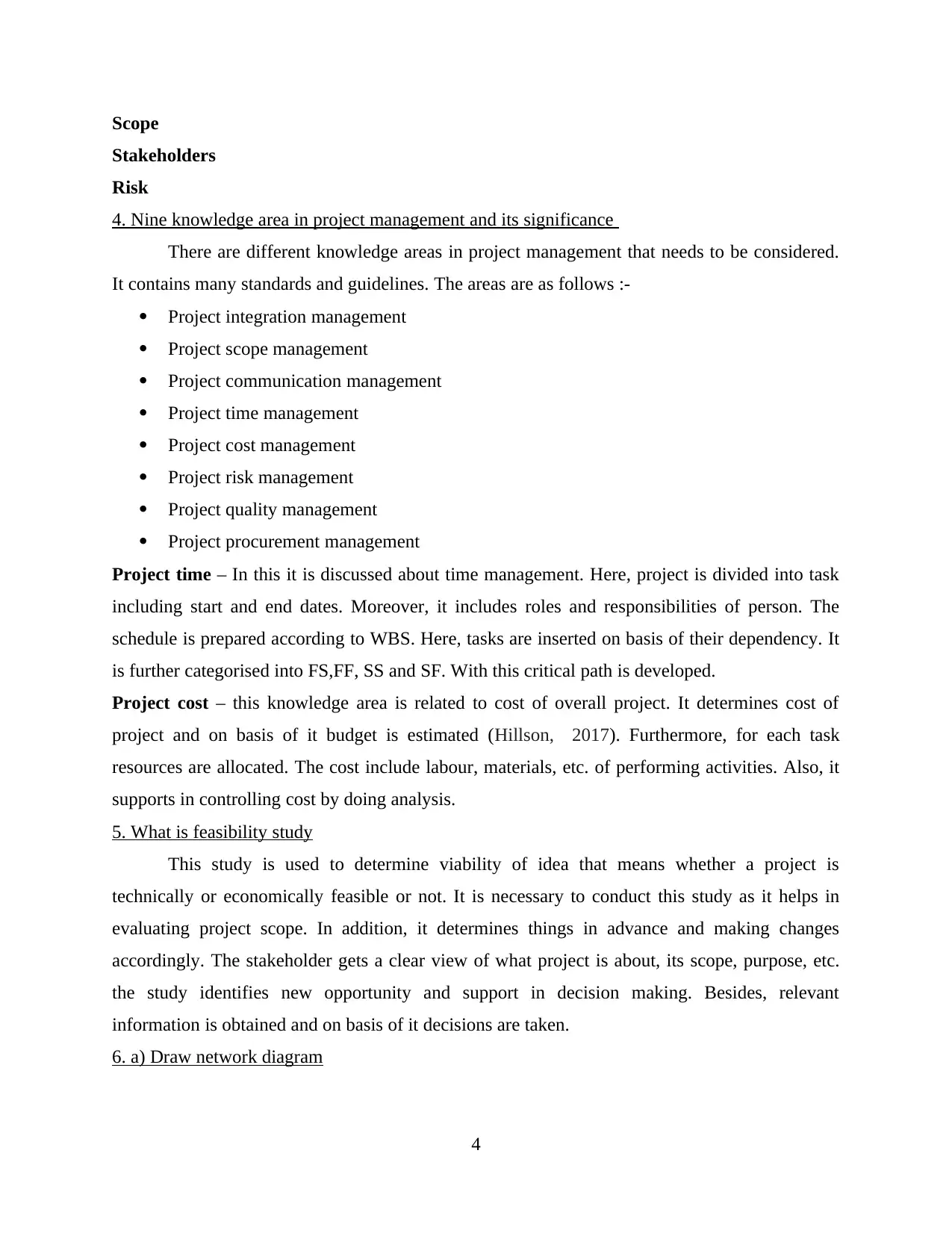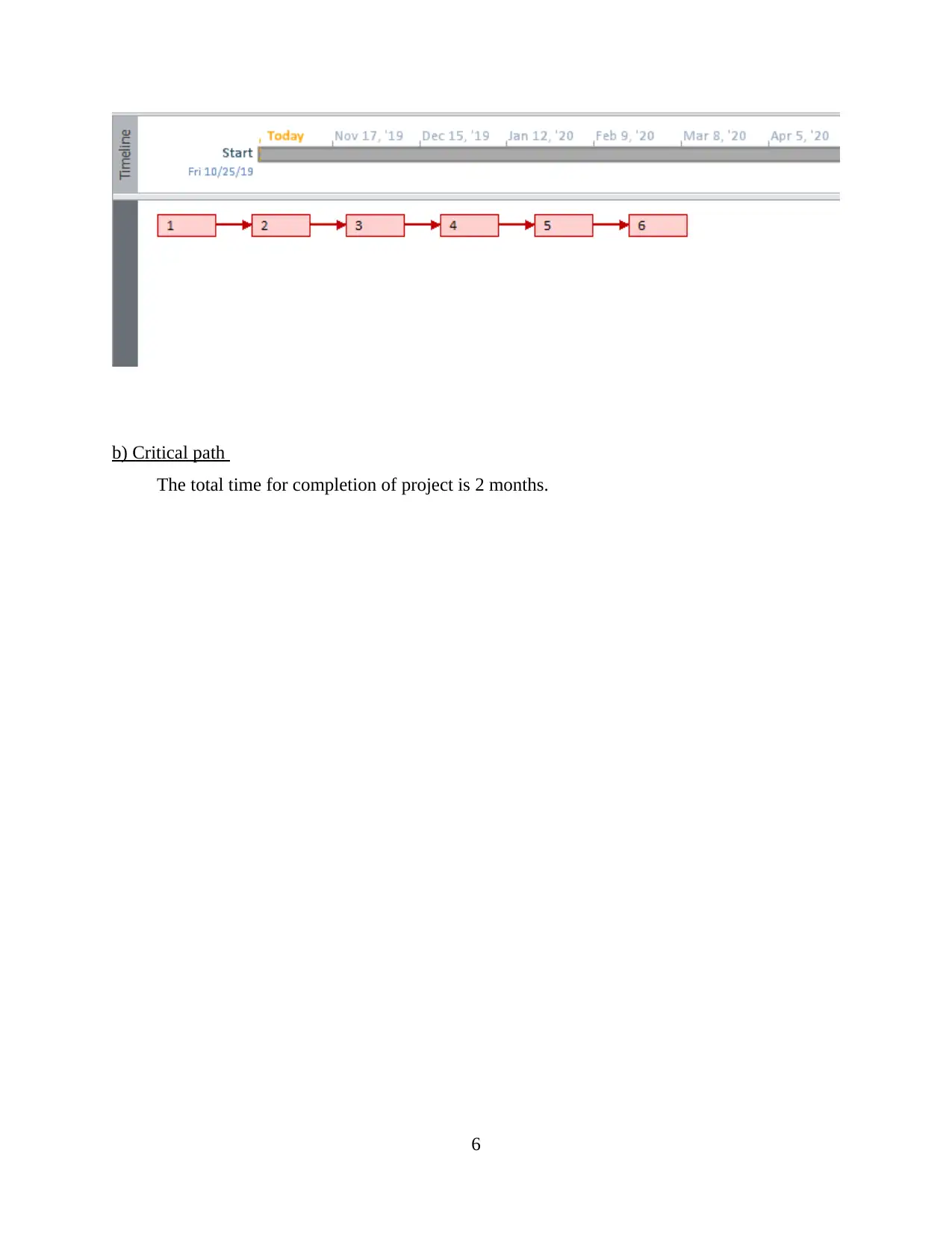Project Management Assignment: PLC, PID, & Network Diagram
VerifiedAdded on 2021/02/22
|7
|957
|189
Homework Assignment
AI Summary
This assignment solution addresses key aspects of project management. It begins by defining project characteristics and their significance, followed by an overview of the project lifecycle (PLC) stages: initiation, planning, implementation, closing, and monitoring. The document explains the purpose of a Project Information Document (PID), emphasizing its role in capturing essential project details such as scope, stakeholders, and risks. It then explores the nine knowledge areas in project management, including project integration, scope, communication, time, cost, risk, quality, and procurement management, highlighting their interdependencies and importance. Furthermore, the solution explains the concept of a feasibility study, outlining its role in determining project viability. The assignment includes a network diagram and critical path analysis based on provided task durations, illustrating project scheduling and dependencies. Finally, the document provides a list of references including books and journals.

Managing Projects
1
1
Paraphrase This Document
Need a fresh take? Get an instant paraphrase of this document with our AI Paraphraser

Table of Contents
TASK 1............................................................................................................................................3
1. Characteristics of project and its importance...........................................................................3
2. List five stage of PLC..............................................................................................................3
3. Purpose of PID.........................................................................................................................3
4. Nine knowledge area in project management and its significance..........................................4
5. What is feasibility study..........................................................................................................4
6. a) Draw network diagram........................................................................................................5
b) Critical path.............................................................................................................................5
REFERENCES................................................................................................................................6
2
TASK 1............................................................................................................................................3
1. Characteristics of project and its importance...........................................................................3
2. List five stage of PLC..............................................................................................................3
3. Purpose of PID.........................................................................................................................3
4. Nine knowledge area in project management and its significance..........................................4
5. What is feasibility study..........................................................................................................4
6. a) Draw network diagram........................................................................................................5
b) Critical path.............................................................................................................................5
REFERENCES................................................................................................................................6
2

TASK 1
1. Characteristics of project and its importance
The six characteristics are as follows :-
A project is developed for customer.
It is temporary in nature that means it has start and end point.
There are unique requirements in project which are to be delivered.
It can be either cross functional or cross organisational.
A project is not business as usual which is more akin to process.
It is an off endeavour rather all time in repeated elements.
Developed for customer- Basically, a project is developed for customer. For this their needs are
identified and then accordingly fulfilled. It can be related to providing services or changing way
of delivering services.
Unique requirement- For every project, its requirements are different. It depends on nature, size
and type of project (Davies and et.al., 2017). However, it is also dependent on customer needs,
scope, etc. of project. So, on basis of project the requirement.
2. List five stage of PLC
Initiation phase- It is starting stage where objectives are identified. Here, feasibility study is
conducted to form project objectives.
Planning phase- in this planning is done that includes team, budget, tasks, time, etc. are
planned. Besides, roles are assigned and resources are allocated according to tasks.
Implementation phase- Here, the project is executed and progress is monitored. The team
perform tasks and compete them.
Closing phase- it is final stage where project is closed. Here, project is evaluated on basis of set
standards to identify whether goals are attained or not.
Monitoring phase- In this project is maintained as per standards and guidelines.
3. Purpose of PID
It is most important document in project. The PID is developed to record basic
information of project that helps in its completion (Defusco and et.al., 2016). It consists of
several elements that are scope, risk stakeholders, etc. that enables in completing project
activities. However, on basis of PID planning is done and task are accomplished. The three
items listed in it are as follows :-
3
1. Characteristics of project and its importance
The six characteristics are as follows :-
A project is developed for customer.
It is temporary in nature that means it has start and end point.
There are unique requirements in project which are to be delivered.
It can be either cross functional or cross organisational.
A project is not business as usual which is more akin to process.
It is an off endeavour rather all time in repeated elements.
Developed for customer- Basically, a project is developed for customer. For this their needs are
identified and then accordingly fulfilled. It can be related to providing services or changing way
of delivering services.
Unique requirement- For every project, its requirements are different. It depends on nature, size
and type of project (Davies and et.al., 2017). However, it is also dependent on customer needs,
scope, etc. of project. So, on basis of project the requirement.
2. List five stage of PLC
Initiation phase- It is starting stage where objectives are identified. Here, feasibility study is
conducted to form project objectives.
Planning phase- in this planning is done that includes team, budget, tasks, time, etc. are
planned. Besides, roles are assigned and resources are allocated according to tasks.
Implementation phase- Here, the project is executed and progress is monitored. The team
perform tasks and compete them.
Closing phase- it is final stage where project is closed. Here, project is evaluated on basis of set
standards to identify whether goals are attained or not.
Monitoring phase- In this project is maintained as per standards and guidelines.
3. Purpose of PID
It is most important document in project. The PID is developed to record basic
information of project that helps in its completion (Defusco and et.al., 2016). It consists of
several elements that are scope, risk stakeholders, etc. that enables in completing project
activities. However, on basis of PID planning is done and task are accomplished. The three
items listed in it are as follows :-
3
⊘ This is a preview!⊘
Do you want full access?
Subscribe today to unlock all pages.

Trusted by 1+ million students worldwide

Scope
Stakeholders
Risk
4. Nine knowledge area in project management and its significance
There are different knowledge areas in project management that needs to be considered.
It contains many standards and guidelines. The areas are as follows :-
Project integration management
Project scope management
Project communication management
Project time management
Project cost management
Project risk management
Project quality management
Project procurement management
Project time – In this it is discussed about time management. Here, project is divided into task
including start and end dates. Moreover, it includes roles and responsibilities of person. The
schedule is prepared according to WBS. Here, tasks are inserted on basis of their dependency. It
is further categorised into FS,FF, SS and SF. With this critical path is developed.
Project cost – this knowledge area is related to cost of overall project. It determines cost of
project and on basis of it budget is estimated (Hillson, 2017). Furthermore, for each task
resources are allocated. The cost include labour, materials, etc. of performing activities. Also, it
supports in controlling cost by doing analysis.
5. What is feasibility study
This study is used to determine viability of idea that means whether a project is
technically or economically feasible or not. It is necessary to conduct this study as it helps in
evaluating project scope. In addition, it determines things in advance and making changes
accordingly. The stakeholder gets a clear view of what project is about, its scope, purpose, etc.
the study identifies new opportunity and support in decision making. Besides, relevant
information is obtained and on basis of it decisions are taken.
6. a) Draw network diagram
4
Stakeholders
Risk
4. Nine knowledge area in project management and its significance
There are different knowledge areas in project management that needs to be considered.
It contains many standards and guidelines. The areas are as follows :-
Project integration management
Project scope management
Project communication management
Project time management
Project cost management
Project risk management
Project quality management
Project procurement management
Project time – In this it is discussed about time management. Here, project is divided into task
including start and end dates. Moreover, it includes roles and responsibilities of person. The
schedule is prepared according to WBS. Here, tasks are inserted on basis of their dependency. It
is further categorised into FS,FF, SS and SF. With this critical path is developed.
Project cost – this knowledge area is related to cost of overall project. It determines cost of
project and on basis of it budget is estimated (Hillson, 2017). Furthermore, for each task
resources are allocated. The cost include labour, materials, etc. of performing activities. Also, it
supports in controlling cost by doing analysis.
5. What is feasibility study
This study is used to determine viability of idea that means whether a project is
technically or economically feasible or not. It is necessary to conduct this study as it helps in
evaluating project scope. In addition, it determines things in advance and making changes
accordingly. The stakeholder gets a clear view of what project is about, its scope, purpose, etc.
the study identifies new opportunity and support in decision making. Besides, relevant
information is obtained and on basis of it decisions are taken.
6. a) Draw network diagram
4
Paraphrase This Document
Need a fresh take? Get an instant paraphrase of this document with our AI Paraphraser

Task Name Duration Start Finish
A 11 wks Fri
10/25/19 Thu 1/9/20
B 9 wks Fri 1/10/20 Thu
3/12/20
C 7 wks Fri 3/13/20 Thu
4/30/20
D 8 wks Fri 5/1/20 Thu
6/25/20
E 11 wks Fri 6/26/20 Thu
9/10/20
F 13 wks Fri 9/11/20 Thu
12/10/20
5
A 11 wks Fri
10/25/19 Thu 1/9/20
B 9 wks Fri 1/10/20 Thu
3/12/20
C 7 wks Fri 3/13/20 Thu
4/30/20
D 8 wks Fri 5/1/20 Thu
6/25/20
E 11 wks Fri 6/26/20 Thu
9/10/20
F 13 wks Fri 9/11/20 Thu
12/10/20
5

b) Critical path
The total time for completion of project is 2 months.
6
The total time for completion of project is 2 months.
6
⊘ This is a preview!⊘
Do you want full access?
Subscribe today to unlock all pages.

Trusted by 1+ million students worldwide

REFERENCES
Books and journals
Davies, A. and et.al., 2017. Five rules for managing large, complex projects. MIT Sloan
Management Review, 59(1), p.73.
Defusco, S.A. and et.al., 2016. System and method for managing projects. U.S. Patent 9,317,825.
Hillson, D., 2017. Managing risk in projects. Routledge.
Davies and et.al., 2017
Defusco and et.al., 2016
Hillson, 2017
7
Books and journals
Davies, A. and et.al., 2017. Five rules for managing large, complex projects. MIT Sloan
Management Review, 59(1), p.73.
Defusco, S.A. and et.al., 2016. System and method for managing projects. U.S. Patent 9,317,825.
Hillson, D., 2017. Managing risk in projects. Routledge.
Davies and et.al., 2017
Defusco and et.al., 2016
Hillson, 2017
7
1 out of 7
Related Documents
Your All-in-One AI-Powered Toolkit for Academic Success.
+13062052269
info@desklib.com
Available 24*7 on WhatsApp / Email
![[object Object]](/_next/static/media/star-bottom.7253800d.svg)
Unlock your academic potential
Copyright © 2020–2025 A2Z Services. All Rights Reserved. Developed and managed by ZUCOL.





